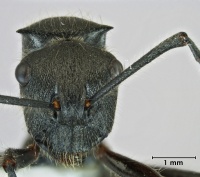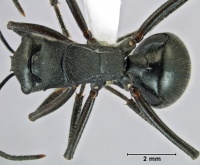Polyrhachis captiva
| Polyrhachis captiva | |
|---|---|

| |
| Scientific classification | |
| Kingdom: | Animalia |
| Phylum: | Arthropoda |
| Class: | Insecta |
| Order: | Hymenoptera |
| Family: | Formicidae |
| Subfamily: | Formicinae |
| Tribe: | Camponotini |
| Genus: | Polyrhachis |
| Subgenus: | Campomyrma |
| Species complex: | gravis |
| Species: | P. captiva |
| Binomial name | |
| Polyrhachis captiva Kohout, 2013 | |
Polyrhachis captiva is the only species of the gravis group known from Victoria. The single known specimen was collected in a pitfall trap on the top of an inland sand dune.
Identification
A member of the Polyrhachis gravis species-group. Kohout (2013) - The unique holotype is a rather large specimen, distinguished from the other species of the group by its relatively large size, a pronotal dorsum with humeri produced into distinct, laminate, triangular teeth and weakly convex lateral margins (Fig. 2E) and a barrel-shaped propodeal dorsum. Postocullar process lacking and carina of dorsoanterior margin of first gastral segment only very weakly indicated. Pilosity very distinct, notably on dorsa of head, mesosoma, appendages and gaster, the later with hairs almost reaching in length the greatest diameter of eye; hairs are virtually absent from sides of mesosoma.
Keys including this Species
Distribution
Latitudinal Distribution Pattern
Latitudinal Range: -34.6° to -34.6°.
| North Temperate |
North Subtropical |
Tropical | South Subtropical |
South Temperate |
- Source: AntMaps
Distribution based on Regional Taxon Lists
Australasian Region: Australia (type locality).
Distribution based on AntMaps
Distribution based on AntWeb specimens
Check data from AntWeb
Countries Occupied
| Number of countries occupied by this species based on AntWiki Regional Taxon Lists. In general, fewer countries occupied indicates a narrower range, while more countries indicates a more widespread species. |

|
Estimated Abundance
| Relative abundance based on number of AntMaps records per species (this species within the purple bar). Fewer records (to the left) indicates a less abundant/encountered species while more records (to the right) indicates more abundant/encountered species. |

|
Biology
Castes
Sexuals and immature stages unknown.
Nomenclature
The following information is derived from Barry Bolton's Online Catalogue of the Ants of the World.
- captiva. Polyrhachis (Campomyrma) captiva Kohout, 2013: 97, figs. 2A-B, E-F (w.) AUSTRALIA.
Unless otherwise noted the text for the remainder of this section is reported from the publication that includes the original description.
Description
Worker
TL c. 11.79; HL 2.68; HW 2.34; CI 87; SL 3.06; SI 131; PW 2.09; MTL 4.03 (1 measured).
Mandibles with 6 teeth, distinctly reducing in length towards base. Anterior clypeal margin widely truncate; truncate portion irregularly denticulate, with angular corners. Clypeus with blunt, poorly defined median carina; straight in profile with flat basal margin. Frontal triangle shallowly impressed. Frontal carinae sinuate with only moderately raised margins; central area with rather flat frontal furrow. Sides of head in front of eyes converging towards mandibular bases in straight line; behind eyes sides rounding into only moderately convex occipital margin. Eyes convex, in full face view clearly breaking lateral cephalic outline. Ocelli lacking. Pronotal humeri armed with distinct triangular laminate, teeth; lateral margins behind humeri weakly emarginate and converging posteriorly in weakly convex line into distinct promesonotal suture. Mesonotal dorsum with anterior corners widely rounded; lateral margins converging posteriorly towards distinct metanotal groove. Propodeal dorsum with lateral margins barrel-shaped and terminating posteriorly in short, upturned, acute teeth; dorsum curving into shallowly concave declivity in medially uninterrupted line. Petiole scale-like, virtually triangular in lateral view; dorsum armed medially with a pair of relatively short and slender, weakly divergent, acute spines; inner margins of spines continuous medially, forming rather narrow, 'U' -shaped dorsum of petiole; outer margins of spines steeply descending into distinct lateral angles, produced into short, acute spines. Gaster in lateral view with anterior face flat; anterior margin of first gastral tergite with blunt, transverse carina.
Mandibles distinctly, longitudinally striate-rugose with numerous piliferous pits. Clypeus reticulate-punctate; head and dorsum of mesosoma reticulate-punctate with sculpture distinctly organised into relatively fine, mostly longitudinal striae; sides of mesosoma finely wrinkled. Petiole with anterior face rather coarsely, transversely reticulate-punctate; posterior face more finely, transversely wrinkled. Gaster very finely shagreened, somewhat semipolished.
Very hairy; mandibles with numerous, curved, golden hairs; truncate median portion of anterior clypeal margin with numerous, relatively long, pale golden setae; numerous shorter setae fringing margin laterally. All body surfaces, including appendages, with semierect to erect, generally long, pale golden or silvery hairs, some almost as long as greatest diameter of eyes. Hairs on head anteriorly inclined, those on dorsum of mesosoma and petiole mostly erect, those on gaster distinctly posteriorly curved. Closely appressed, greyish pubescence present only on anterior face of fore coxae, virtually absent from rest of body.
Mandibles distinctly reddish-brown towards masticatory borders; antennae virtually black with only apical funicular segments reddish-brown. Legs very dark reddish-brown; tarsi black with apical segments rather light reddish-brown. Venter and apex of gaster dark reddish-brown.
Type Material
- Holotype, worker, Nowingi, Victoria, Australia, 34°36′0″S 132°13′0″E / 34.6°S 132.216667°E, 20-23.xi.2004, DPI PIRVic Knoxfield, Australian National Insect Collection; top of sand dune, pitfall trap.
Etymology
Derived from the Latin captivus, meaning 'taken prisoner' in reference to the unique holotype being caught in a pitfall trap.
References
References based on Global Ant Biodiversity Informatics
- Kohout R.J. 2013. A Review of the Polyrhachis gravis and micans species-groups of the subgenus Campomyrma Wheeler (Hymenoptera: Formicidae: Formicinae). Memoirs of the QLD Museum-Nature 56: 92-117

